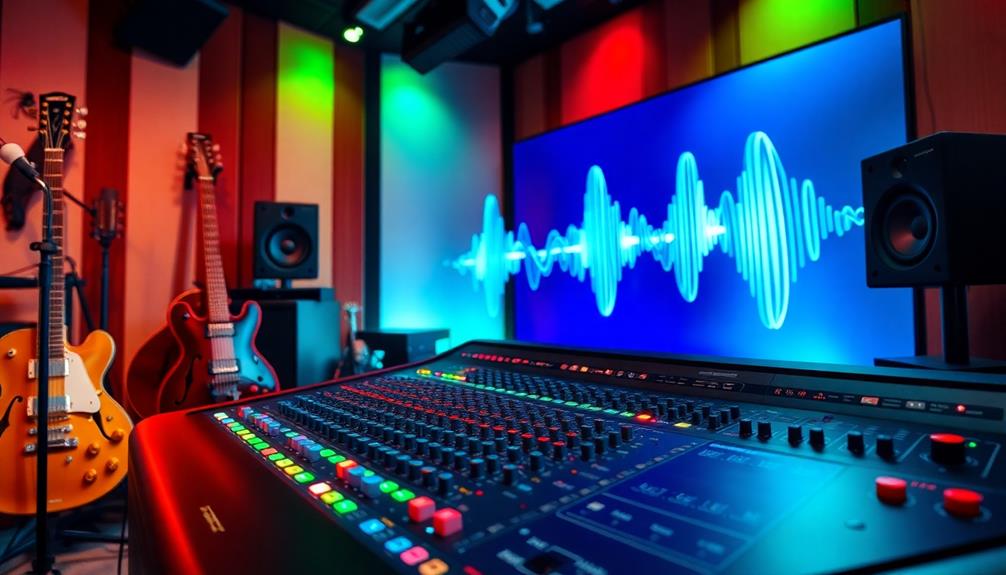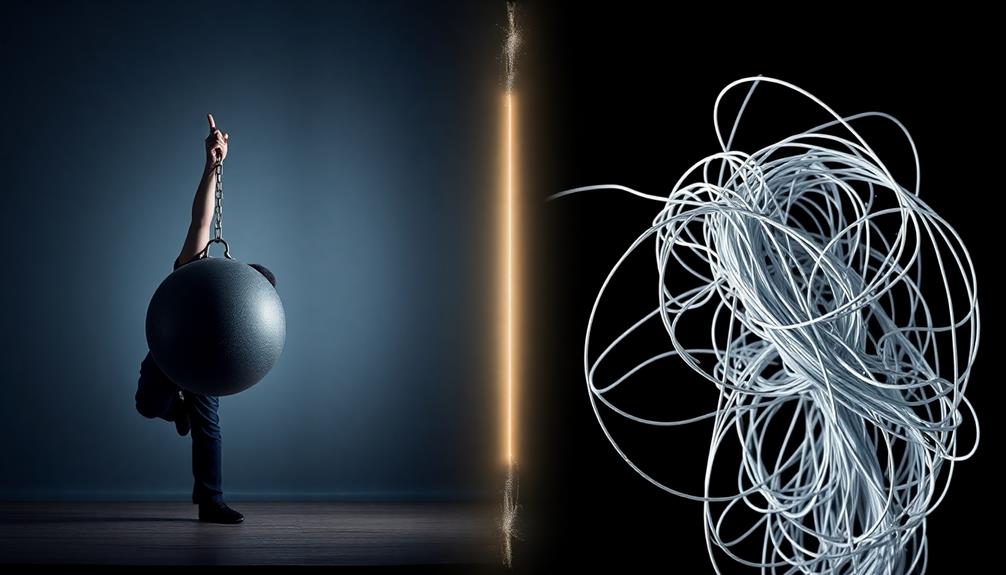To achieve a balanced mix, start by centering low-frequency instruments, like bass and kick drums, to create a strong foundation. Then, pan higher frequencies outward for clarity and separation. Use hard panning for doubled instruments to enhance their distinction, while keeping softer elements in the center for cohesion. Dynamic panning can really spice things up—narrow your stereo field in verses, then widen it in choruses for contrast. Be cautious of over-panning to avoid an unbalanced mix. With these techniques in mind, you can create an engaging soundscape that captivates your listeners. There's plenty more to explore!
Key Takeaways
- Center low-frequency instruments like bass and kick drum to provide a solid foundation for your mix.
- Utilize hard-panning for doubled instruments to enhance clarity and prevent frequency masking.
- Balance centered low frequencies with wide panning of high frequencies for a dynamic and engaging sound.
- Regularly check your mix in mono to ensure compatibility and clarity of hard-panned elements.
- Implement dynamic panning strategies, such as widening the stereo field in choruses, to maintain listener interest and emotional flow.
Understanding Audio Panning

When you immerse yourself in audio panning, you'll discover it's all about adjusting sound placement between the left and right channels to create a more immersive experience. Panning helps you achieve a well-defined stereo image, allowing each instrument to occupy its own space within the mix.
By manipulating the pan pot, you can distribute sounds across the stereo field, simulating how you naturally perceive sound with your two ears.
In audio mixing, understanding frequency placement is essential. You'll want to center low frequencies, as they provide a foundation, while strategically panning high frequencies enhances clarity and separation.
This technique prevents competition between instruments, making it easier for you to identify each sound's position. By lowering the volume in one channel and increasing it in another, you utilize psychoacoustic effects that enhance the listening experience, improving sound localization.
Ultimately, effective panning not only enhances audio quality but creates a more engaging experience for listeners. The right panning choices can transform your mix, bringing out the best in every instrument and ensuring each element shines in its own spotlight.
Embrace these techniques, and watch your mixes come to life.
Benefits of Panning in Music
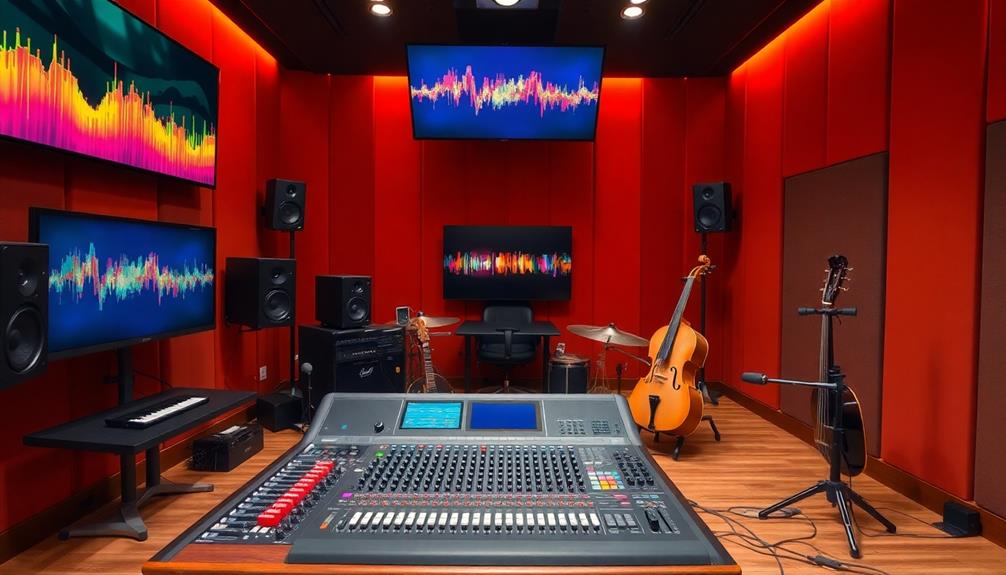
Panning offers a wealth of benefits that can greatly elevate your music mixes. By employing effective panning techniques, you can enhance stereo separation, allowing each instrument to shine while improving clarity in a mix. This prevents frequency masking and keeps your tracks distinct.
Using panning wisely also creates realistic listening experiences, simulating a 3D sound environment that engages listeners. Positioning low-frequency instruments, like bass and kick drums, in the center helps maintain balance and stability in your mix, which is essential for foundational elements.
To illustrate the benefits of panning, consider the following table:
| Benefit | Description | Effect on Mix |
|---|---|---|
| Stereo Separation | Distinct positioning of instruments | Improved clarity and definition |
| Realistic Listening | Simulated 3D environment | Engages listeners effectively |
| Clarity in a Mix | Prevents frequency masking | Clearer soundscape |
| Dynamic Panning | Varying width for sections | Enhanced listener engagement |
Practical Panning Techniques
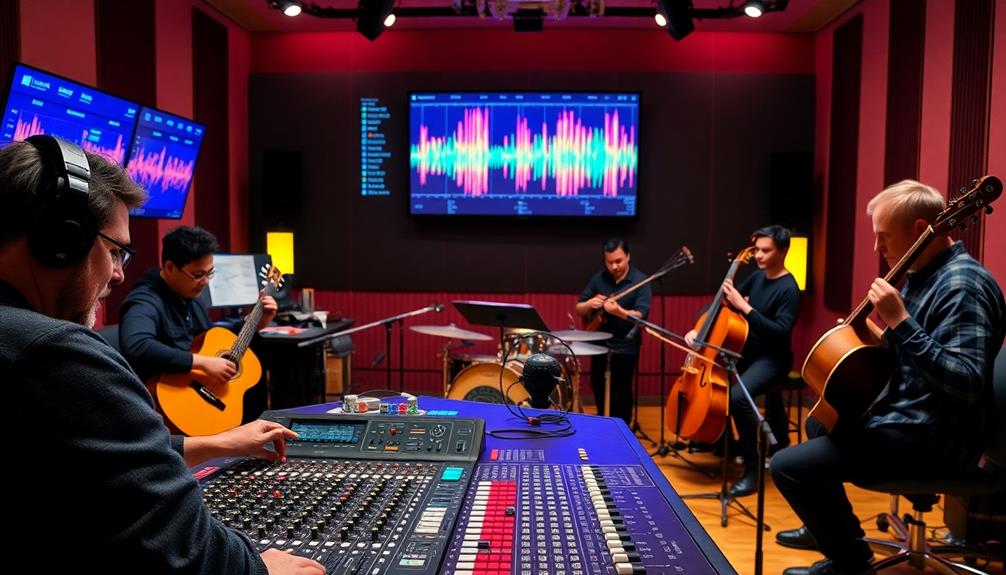
When you start mixing, center low-frequency instruments like the bass and kick drum to build a solid foundation.
Next, try hard-panning doubled instruments, such as guitars or synths, to enhance clarity and create a richer stereo image.
This balance between centered lows and wide panning can make your mix more dynamic and engaging.
Hard-Panning Instruments Effectively
Utilizing hard-panning techniques can greatly enhance your mix by giving each instrument its own distinct space in the stereo field. When you hard pan double-tracked instruments, like electric guitars and synths, fully to the left and right, you create a fuller, more dynamic sound that engages listeners. This approach helps improve clarity in the mix, preventing frequency masking that can muddle your lead vocals.
To effectively implement hard panning, remember to keep low frequencies, such as kick drums and bass, centered. This balance maintains stability in your mix while allowing higher-frequency elements to shine. Genres like rock and EDM benefit from this wide soundstage, creating an immersive listening experience that captures your audience's attention.
While hard-panned instruments can create contrast and excitement, be cautious not to overwhelm your listeners. Incorporate softer elements in the center to balance the mix, ensuring it remains cohesive and dynamic.
Mixing in mono can also help you gauge how well your hard-panned elements translate across different listening environments, further improving the overall impact of your mix.
Centering Low Frequencies
Centering low frequencies is essential for creating a solid backbone in your mix. When you center instruments like the kick drum and bass guitar, you maintain their impact, ensuring they drive the track forward. This approach prevents muddiness and keeps low-end clarity, which is vital for a cohesive sound.
By centering low frequencies, you allow higher frequency instruments to be panned away from the center, reducing competition in the stereo field. This technique aligns with psychoacoustic principles, as our ears localize bass sounds less effectively. Consequently, placing these frequency instruments in the center enhances the overall listening experience.
To maximize the effectiveness of centering low frequencies, make sure to complement them with proper EQ and compression techniques. This helps them sit well in the mix, allowing for clearer separation from other elements.
When you mix in mono, you can further assess the balance of your low frequencies, ensuring they form a solid foundation for your track.
Incorporate these practical audio panning techniques to release tension in your mix and create a more dynamic sound. Ultimately, centering low frequencies is key to achieving a professional-level mix.
Panning in Visual Media
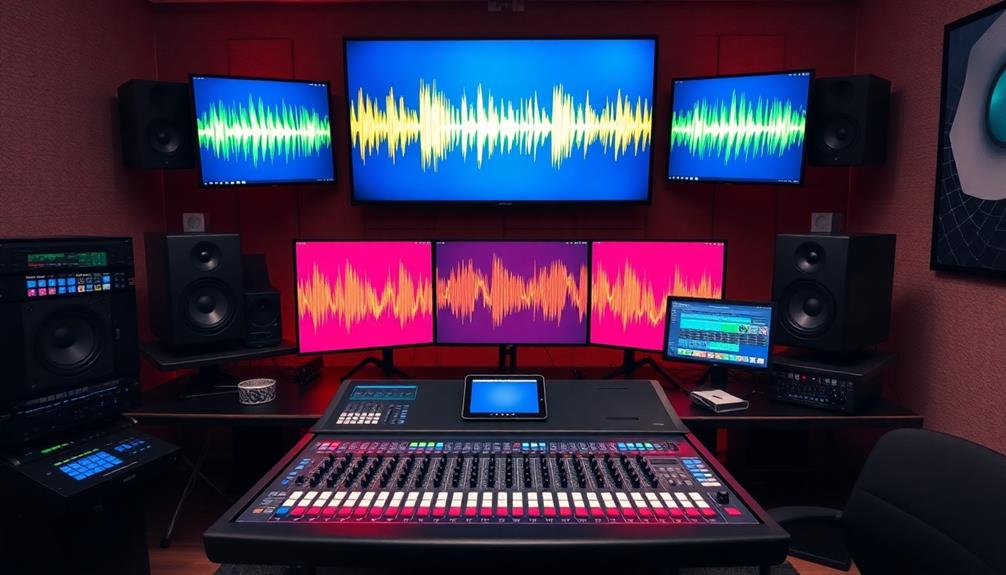
In modern filmmaking and video production, panning plays an essential role in creating an immersive experience for viewers. By effectively panning voice across the stereo field, you can enhance realism and direct attention during key scenes. This technique follows actor movements, ensuring that audio aligns with visual storytelling, which greatly improves narrative impact.
When you utilize panning for ambient sounds, such as traffic or environmental noises, you create immersive soundscapes that engage the audience and enhance their sense of presence in a scene. Effective audio panning simulates the experience of space and depth, making scenes feel more dynamic and lifelike.
In video game audio design, implementing panning allows for realistic interactions, as sounds shift directionally with player movements. This directional sound not only enhances immersion in virtual environments but also strengthens emotional responses tied to the visuals.
Dynamic Panning Strategies
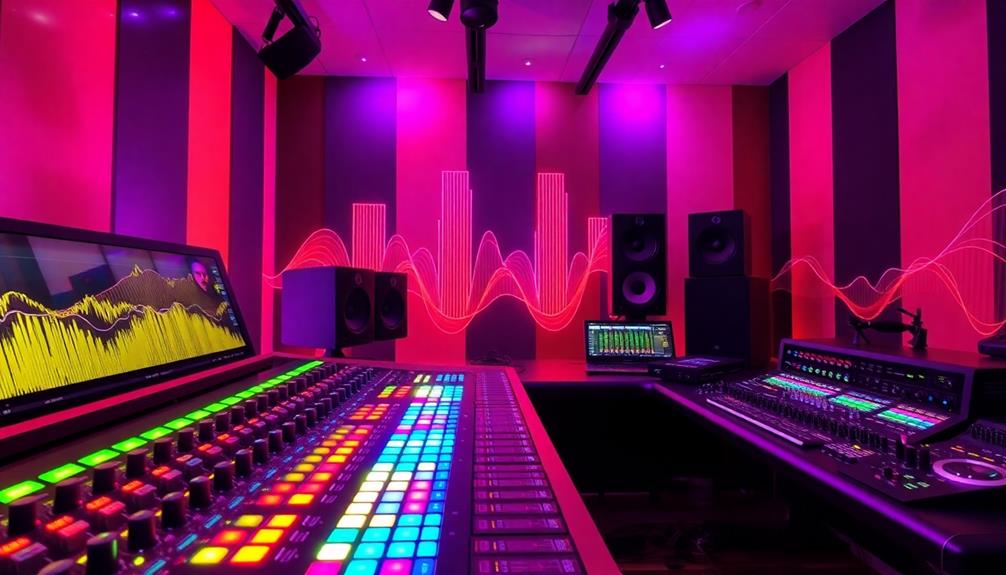
When you apply dynamic panning, consider narrowing the stereo field during verses and widening it in choruses to create contrast.
This approach not only maintains listener interest but also enhances the emotional flow of the track.
Additionally, experimenting with relaxed versus stressed panning can help convey different moods throughout your mix.
Narrow Verses, Wide Choruses
Balancing narrow panning in verses with wide panning in choruses can dramatically enhance your mix. This approach not only creates contrast but also engages listeners more deeply. Here are three key benefits:
- Intimacy in Verses: Using narrow panning allows you to craft an intimate feel, focusing attention on lyrical content and subtle instrumentation details.
- Impactful Choruses: Expanding the stereo field during choruses with wide panning enhances emotional impact. This makes the chorus feel more powerful and engaging, capturing the listener's attention.
- Dynamic Movement: Implementing dynamic panning strategies keeps the arrangement evolving, creating a dynamic listening experience that feels intentional and polished.
To achieve seamless shifts between narrow and wide panning, leverage automation. This technique can enhance the perceived loudness and emotional responses from listeners, establishing a balanced mix.
By alternating between narrow and wide panning, you'll evoke stronger connections to the music. As you experiment with these strategies, consider how the instrumentation interacts within the stereo field to maximize the emotional impact.
Embrace these techniques to elevate your mixes and captivate your audience!
Relaxed vs. Stressed Panning
Panning techniques can make or break the emotional landscape of a track, so it's crucial to understand the difference between relaxed and stressed panning.
Relaxed panning involves subtle movements within the stereo field, creating a warm, inviting soundscape that captivates listeners without overwhelming them. This approach helps maintain mix balance while allowing you to engage your audience effectively.
On the other hand, stressed panning features abrupt or extreme shifts in panning positions, generating tension and excitement. While this technique can enhance emotional impact, it risks disrupting the overall mix balance, potentially leading to listener discomfort.
Utilizing dynamic panning strategies, like gradually adjusting pan positions throughout a track, can keep listeners intrigued. For instance, soft panning techniques evoke intimacy in quieter passages, while harsher panning adds dynamic contrast in high-energy sections.
Experimenting with both relaxed and stressed panning can lead to innovative soundscapes, enabling you to define the character and emotional arc of your track.
Common Mixing Mistakes

Many mixers stumble into common pitfalls that can compromise the quality of their work. Here are three mistakes to watch out for:
- Over-panning: Panning too aggressively can lead to an unbalanced mix. It's crucial to maintain mono compatibility, as sounds can get lost or diminished on certain playback systems.
- Ignoring frequency overlap: When you don't consider how instruments occupy the same frequency range, you risk muddiness in your mix. Instruments may mask each other, reducing clarity.
- Neglecting playback references: Failing to check your mix on various systems can create an inconsistent listener experience. A mix that sounds great on studio monitors might be unbalanced on earbuds.
To avoid these mistakes, regularly check your levels using level meters while panning to guarantee a consistent balance.
Excessive hard panning can lead to listener fatigue, making the mix feel less engaging. Aim for a well-rounded stereo image that keeps your audience interested without overwhelming them.
Tools for Effective Mixing
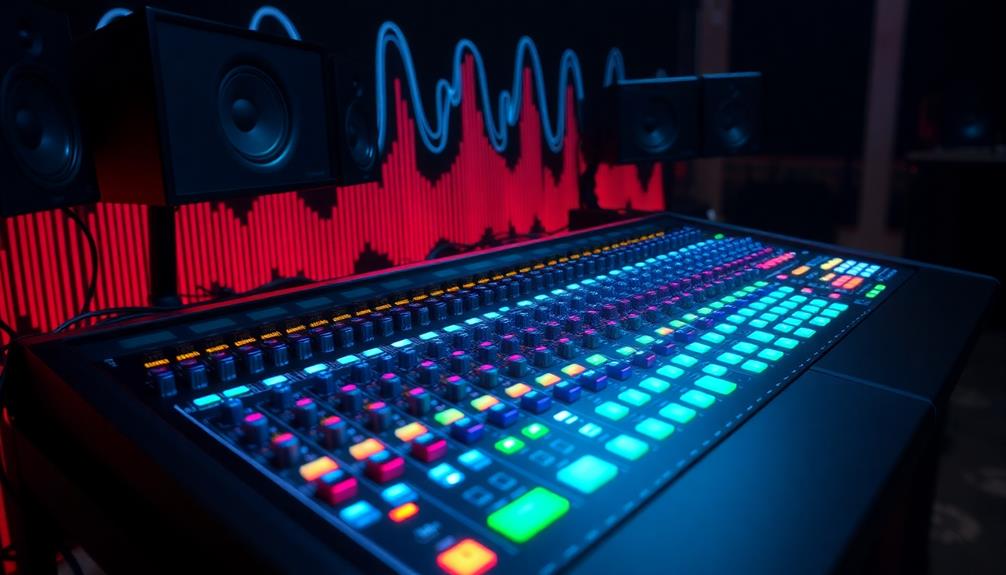
Achieving a polished mix goes beyond avoiding common mistakes; it involves leveraging the right tools to enhance your audio. Start with your Digital Audio Workstation (DAW), where you can utilize built-in panning controls for precise placement of sounds within the stereo field. This guarantees that you achieve balance across all elements of your mix, especially when considering various playback systems.
Additionally, keep in mind the importance of cybersecurity measures, as cybersecurity vulnerabilities can impact your workflow, especially when working on collaborative projects online.
Consider exploring third-party plugins, such as stereo imaging tools, to enhance spatial qualities and gain greater control over stereo width. Implement mid/side processing techniques to manipulate the panned center and the sides of your mix independently. This allows for more nuanced stereo imaging, making your tracks feel more dynamic.
Use visual meters and spectrum analyzers to monitor stereo balance and frequency distribution. These tools help identify potential conflicts, guaranteeing a cohesive mix.
Don't forget about automation features in your DAW; they enable you to create dynamic panning effects, adding movement and interest to your tracks. By utilizing these tools for effective mixing, you can elevate your mixing and mastering process, resulting in a professional-sounding final product.
Frequently Asked Questions
What Is the Most Common Panning Technique?
The most common panning technique is center panning. You typically place lead vocals, kick drums, and bass guitars in the center. This approach guarantees these key elements stand out clearly in the overall mix.
How Do You Get a Well Balanced Mix?
Imagine you're mixing a lively band. Start by leveling each instrument, center the vocals and bass, then check in mono. This way, you guarantee clarity and balance, making your mix sound great across all systems.
What Are the Different Types of Panning?
You've got several types of panning to explore. Hard panning places sounds fully left or right, while center panning keeps essential elements grounded. LCR, complementary, and dynamic panning add depth and clarity to your audio experience.
What Is the Difference Between Panning and Balancing?
Did you know that 70% of listeners notice panning differences? Panning distributes sounds side-to-side, while balancing adjusts volume levels. You'll create clarity and cohesion by mastering both techniques in your audio projects.
Conclusion
Incorporating essential panning techniques can elevate your mix from good to absolutely mind-blowing. By understanding and applying these strategies, you'll create a balanced soundstage that draws listeners in like a moth to a flame. Don't forget to avoid common pitfalls and experiment with dynamic panning to keep things fresh. With the right tools at your disposal, you'll be well on your way to crafting mixes that resonate and captivate. Happy mixing!

